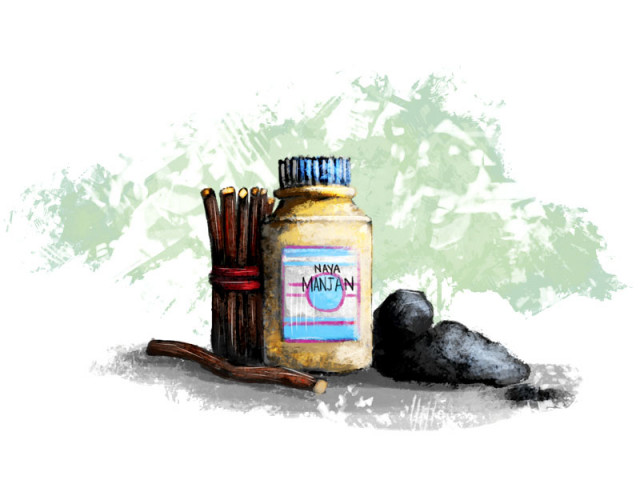The secrets behind their smile
For a great many Pakistanis, the secret behind a dazzling smile doesn’t come out of a tube of toothpaste.

The secrets behind their smile
Ever wonder why some people still use a jagged twig to brush their teeth? In an age when shelves in every pharmacy and grocery store are overflowing with multiple brands of toothpastes, it’s hard for us to imagine that people still continue to use some of the ‘exotic’ — or rather old-fashioned — ways to clean their teeth. But neither the copious supply of sparking gels and minty crystals, nor the promise of glistening white teeth will convince some people to abandon traditional methods of cleaning their teeth. And for others, it’s simply more economical to chew on miswak, or use their index fingers to keep their teeth manjan-fresh.
Most people living in urban centres use toothpaste and a toothbrush for maintaining oral hygiene. But for those in rural areas, the options for cleaning teeth and gums can be radically different.
Even though there is no formal documentation to back this, traditional practices of maintaining oral hygiene actually vary according to geographical locations. For example, people living in Sindh may not necessarily clean their teeth the same way as those in Punjab.
“In the rural areas of Sindh, due to scarce resources people would use ash with salt and sometimes coal with oil,” explains Dr Aamir Warsi, consultant dental surgeon and senior registrar for Karachi Medical and Dental Council (KMDC). While ash and salt may seem like a rather revolting combination, it is actually effective for teeth cleansing. “Salt also helps in whitening — which remains a misleading indicator for healthy teeth. But that is another story,” adds Warsi.
But as we move past the desert landscape, the means of oral upkeep change.
“As we go further into central Punjab, teeth are cleaned using fleshy sticks, skinny portions of different plants specifically called ‘dandaasaa’ as well as locally made manjan powder,” explains Warsi.
On the other hand, in Khyber-Pakhtunkhwa and Balochistan, people use more aggressive methods for cleaning their teeth due to the high protein content in the diet, explains Warsi. “These include abrasives such as wooden sticks, and harder fibrous miswak,” says the consultant dentist. “In fact, I personally know some areas of Chitral where people use a fine metallic wire for flossing.”
Other traditional methods for maintaining oral hygiene are ground coal powder, plain ash, the sticky twigs of neem trees and a chemical concoction containing sodium bicarbonate.
Interestingly, even within a province, there are certain pockets where tooth cleansing practices differ from the rest of the area. For instance, the use of manjan— a powder concoction which typically contains herbs, oil of clove and black pepper among other ingredients—is also fairly common in Sindh. Experts attribute this to people migrating from one province to another, and continuing their tradition of specific practices of oral cleanliness.
While there is a regional variation in the way people clean their teeth, the most popular traditional methods across Pakistan are miswak and manjan. “Of all the traditional methods for maintenance of oral hygiene in Pakistan the most popular are miswak and manjan,” says Dr Rafique Ahmed Memon, Chairman for the Dental Education Committee of the Pakistan Medical and Dental Association (PMDC). “But miswak takes precedence because it is associated with the Holy Prophet Muhammad(pbuh).” Another reason for miswak’s popularity is because the contents of manjan are largely unknown to most people and differ from one area to another.
While many traditional methods can perform the basic abrasive, anti-inflammatory and antiseptic functions required to clean teeth and maintain oral hygiene, some of them can actually cause serious damage to a person’s teeth and gums in the long run.
Dr Faisal Qayyum, consultant prosthodontist at the Aga Khan University Hospital (AKUH), strongly cautions against using manjan to ensure clean teeth. “Besides most people not knowing its contents, it is very abrasive. Its long term use leads to the possibility of heightened teeth sensitivity, as well as receding and bleeding gums.”
Additionally, the way manjan — and even other substances like coal and ash — are applied to the teeth is also questionable. “Unlike a flexible and smooth toothbrush, the finger usually cleans just the front teeth,” Memon says. Thus, the teeth located further inside the mouth — bicuspids, molars and wisdom teeth — are not cleansed properly.
This means that food particles are not removed from inter-dental spaces which then cause gingivitis and tartar. Another problem with these methods is the constant pressure exerted on the front teeth.
“In some cases, e.g. when using ash, the substance may be too harsh and using your finger for its application exerts additional pressure which, in the long run, strains your teeth,” explains Memon. The coarseness of coal will also in the short- and long-term strip teeth enamel.
Those using miswak are still better off, says Qayyum. “The person chews on the wooden stick thus generating saliva which mixes with the antibacterial properties [of the miswak] to cleanse teeth and gums.” However, Qayyum cautions that since no published work is available to compare the properties of toothpaste versus miswak, any comments in this regard cannot be made with authority.
Unlike several traditional ways of maintaining oral cleanliness, toothpaste actually protects teeth in the long-run. Teeth have slight spaces or gaps on their surface. The components of toothpaste — fluoride with antibacterial properties, and strontium which mitigates teeth sensitivity — help ‘pack’ these gaps to prevent bacteria from damaging teeth. “Put simply, the salt and iron [in toothpaste] packs these gaps and reduces tooth sensitivity,” Qayyum explains.
Still, thousands all over the country continue to use traditional means for oral cleanliness. “This is mainly due to lack of awareness and then lack of affordability [for other options],” says Qayyum. “But it is also because it is a cultural and traditional practice that people have seen in their families for generations, especially in joint families.”
Published in The Express Tribune, March 21st, 2012.

















COMMENTS
Comments are moderated and generally will be posted if they are on-topic and not abusive.
For more information, please see our Comments FAQ